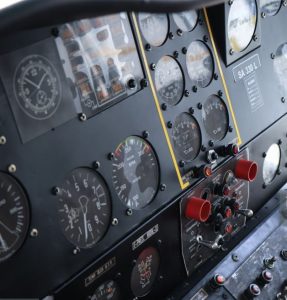How AI-DA Can Revolutionise Airline Pilot Training
 The aviation industry is constantly evolving, with technology playing an increasingly central role in shaping the way pilots are trained. One of the most promising advancements in recent years is the integration of AI-DA into pilot training programs. AI-DA combines machine learning, natural language processing, and real-time data analytics to create a personalized, adaptive, and highly efficient training environment for pilots. This article explores how AI-DA can transform the training of airline pilots, enhancing safety, efficiency, and the overall quality of training.
The aviation industry is constantly evolving, with technology playing an increasingly central role in shaping the way pilots are trained. One of the most promising advancements in recent years is the integration of AI-DA into pilot training programs. AI-DA combines machine learning, natural language processing, and real-time data analytics to create a personalized, adaptive, and highly efficient training environment for pilots. This article explores how AI-DA can transform the training of airline pilots, enhancing safety, efficiency, and the overall quality of training.
Growing need for AI-DA
As global air travel continues to grow, the demand for highly trained pilots has never been higher. According to the International Air Transport Association , the aviation industry is expected to require more than 500,000 new pilots over the next 20 years to keep up with increasing demand. This is compounded by the fact that training a pilot is a lengthy and expensive process, often taking years to complete, with significant costs for both flight schools and airlines. As a result, there is a pressing need for more efficient, scalable, and effective pilot training programs.
Traditional pilot training, while effective, has limitations. It typically involves classroom instruction, flight simulators, and hands-on experience in real aircraft. However, these methods are often time-intensive and expensive, and they may not fully address individual learning needs or adapt to rapidly changing aviation environments. This is where AI-DA comes in, offering a new, technology-driven approach to pilot training.
What is AI-DA?
AI-DA, or Artificial Intelligence-Driven Assistance, is a technology that uses artificial intelligence to enhance human learning and decision-making. In the context of pilot training, AI-DA refers to AI-powered tools and systems that assist flight instructors and students throughout the training process. By leveraging advanced algorithms, real-time data, and personalized learning techniques, AI-DA creates a dynamic, adaptive training environment that can adjust to the specific needs of each trainee, track their progress, and provide instant feedback.
AI-DA systems incorporate a range of technologies, including:
- Machine learning: AI algorithms analyse vast amounts of data from flight simulations, sensor inputs, and previous training sessions to identify patterns in pilot behaviour, predict performance, and offer tailored recommendations.
- Natural language processing: NLP allows for real-time communication between the AI system and the trainee, enabling voice interactions, feedback, and suggestions. This can simulate real-world in-flight scenarios, allowing pilots to practice handling emergencies and complex situations.
- Data analytics: AI-DA systems continuously analyse data from various sources to provide insights into performance, decision-making, and overall progress.
Benefits of AI-DA in airline pilot training
1) Personalised learning experience
The standout feature of AI-DA is its ability to deliver highly personalized training programs. Traditional training methods often take a one-size-fits-all approach, which may not cater to the unique strengths, weaknesses, and learning styles of individual pilots. AI-DA, on the other hand, can analyze data from each trainee’s performance and create a customized training plan that targets areas of improvement.
By continuously monitoring the pilot’s progress, AI-DA can adjust the difficulty of simulations, offer additional practice on specific maneuvers, and provide feedback that helps the trainee grow at their own pace. This ensures that every pilot receives a training experience that aligns with their needs, ultimately leading to better results and faster learning.
2) Real-time feedback and performance monitoring
AI-DA systems can provide real-time feedback to pilots during training sessions. This instant feedback is a crucial aspect of effective learning, as it allows pilots to make immediate adjustments to their actions and decisions. Unlike traditional flight training, where feedback may be delayed until the end of a session or only provided by an instructor, AI-DA ensures that trainees receive continuous performance insights.
For example, if a pilot is practicing an emergency landing and makes a mistake, AI-DA can instantly alert the trainee to the error, explain what went wrong, and suggest corrective actions. This feedback can be much more detailed than what a human instructor could provide, as AI-DA systems can analyze data from various sources (such as aircraft sensors, cockpit behavior, and environmental conditions) to identify specific areas for improvement.
Moreover, AI-DA systems can track a pilot’s performance over time, offering a clear picture of their strengths and weaknesses. This allows flight schools and airlines to monitor trainees’ progress more effectively and make informed decisions about their readiness for more advanced training or real-world flying.
3) Simulating complex scenarios and emergencies
One of the most significant advantages of AI-DA is its ability to simulate complex and high-stress flight scenarios. While traditional flight simulators are already an essential tool for pilot training, AI-DA can enhance these simulations by introducing highly realistic, adaptive, and unpredictable situations.
AI-driven systems can simulate a wide range of emergency situations, such as engine failure, sudden weather changes, or system malfunctions, that require immediate decision-making and quick thinking. These scenarios can be adjusted dynamically based on the trainee’s progress and performance, ensuring that they are challenged in a way that mirrors real-life conditions.
In addition, AI-DA systems can replicate various environmental factors, such as shifting weather patterns, fluctuating air traffic, and changes in flight conditions. This allows pilots to experience a more comprehensive range of potential situations, helping them develop critical problem-solving skills and improving their ability to stay calm and effective under pressure.
4) Cost-effectiveness and efficiency
Pilot training is notoriously expensive, with the cost of flight hours, equipment, and instructors adding up quickly. AI-DA can help reduce some of these costs by enabling more efficient training methods. Because AI-DA systems can simulate complex flight scenarios and provide personalized instruction without requiring an instructor to be present at all times, they can reduce the need for costly flight hours and in-person training.
Furthermore, AI-DA systems can accelerate the training process by offering tailored lessons and immediate feedback, allowing pilots to spend more time refining their skills and less time waiting for instructor availability. This leads to faster training cycles, ultimately saving both time and money for flight schools and airlines.
5) Increased safety and risk mitigation
Safety is a top priority in aviation, and pilot training plays a critical role in ensuring that pilots are prepared to handle all potential risks. AI-DA can enhance safety by providing more realistic and challenging training environments, as well as by identifying potential safety risks before they arise.
AI systems can track a trainee’s actions and decisions in real time, offering suggestions for safer flight techniques and identifying risky behaviors, such as improper handling of instruments or failure to follow protocols. By learning from each training session, AI-DA helps pilots internalize best practices and avoid dangerous mistakes in the future.
Additionally, AI-DA systems can offer insights into long-term patterns, identifying areas where a pilot may consistently struggle or face challenges. This allows instructors to intervene early, offering targeted training and ensuring that safety concerns are addressed before they become problematic.
6) Scalability for airlines and training schools
AI-DA’s ability to deliver personalized training at scale makes it an invaluable tool for airlines and flight schools looking to train large numbers of pilots. Traditional training methods often require a significant investment of resources, including instructors, simulators, and flight hours. By integrating AI-DA, flight schools and airlines can automate much of the training process, providing high-quality instruction to a larger pool of trainees without compromising on safety or effectiveness.
With AI-DA, training programs can be delivered remotely or in hybrid formats, allowing trainees to engage with training materials at their own convenience. This flexibility makes it easier to accommodate the growing demand for pilots, especially in regions or organisations that may not have access to advanced training equipment or instructors.
How AI-DA works in the pilot training ecosystem
AI-DA systems are not meant to replace human instructors; rather, they serve as a powerful supplement to traditional training methods. The ideal pilot training program combines the strengths of human expertise with the advantages of AI-driven systems, ensuring that trainees receive the best of both worlds.
1) Integration with flight simulators: AI-DA can be integrated into existing flight simulators, enhancing their capabilities by providing real-time feedback, adaptive difficulty levels, and personalised training sessions. The AI system can track the pilot’s actions and suggest improvements, while also simulating real-world challenges that require quick decision-making.
2) Support for classroom learning: AI-DA can also support classroom instruction by offering interactive lessons, quizzes, and assessments that adapt to the learner’s progress. By analyzing performance data from these activities, AI-DA systems can recommend additional resources or practice areas to help trainees master key concepts and skills.
3) Collaboration with instructors: Human instructors still play a crucial role in pilot training, especially when it comes to teaching advanced concepts, providing mentorship, and evaluating the emotional and psychological aspects of a trainee’s development. AI-DA works alongside instructors to streamline administrative tasks, track trainee progress, and identify areas where additional human intervention may be needed.
In conclusion
AI-DA is poised to revolutionize the way airline pilots are trained, offering personalized, data-driven, and highly efficient training experiences. By providing real-time feedback, simulating complex scenarios, and enhancing safety, AI-DA has the potential to reduce training costs, increase the speed at which pilots are trained, and improve flight safety.
As the aviation industry faces increasing demand for qualified pilots and seeks to adopt more cost-effective and scalable training solutions, AI-DA will play an increasingly important role. The future of airline pilot training is digital, adaptive, and intelligent, and AI-DA is at the forefront of this transformation. By leveraging the power of artificial intelligence, the aviation industry can ensure that pilots are better prepared than ever to meet the challenges of modern air travel.










